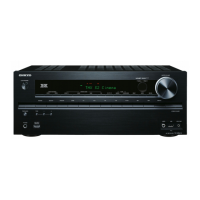Appendix
En-89
Connection Tips and
Video Signal Path
The AV receiver supports several connection formats for
compatibility with a wide range of AV equipment. The
format you choose will depend on the formats supported by
your components. Use the following sections as a guide.
Video components can be connected by using any one of
the following video connection formats: composite video,
component video, or HDMI, the latter offering the best
picture quality.
Tip
• For optimal video performance, THX recommends that video
signals pass through the system without upconversion (e.g.,
component video input passing through to component video
output).
• To by-pass the upconversion, set the “Picture Mode” setting to
“Direct” (➔ page 61).
■ “Monitor Out” set to “HDMI Main” or “HDMI
Sub”
Video input signals flow through the AV receiver as
shown, with composite video and component video
sources all being upconverted for the HDMI output. Use
these settings if you connect either HDMI OUT MAIN or
HDMI OUT SUB of the AV receiver to your TV.
The composite video and component video outputs pass
through their respective input signals as they are.
Note
• When composite video and component video sources are
upconverted for HDMI OUT SUB, only signals with a resolution
of 480i/576i are output and the resolution remains the same. If
your TV doesn’t support this resolution, there will be no picture
(➔ page 91).
■ “Monitor Out” set to “Both”
Video input signals flow through the AV receiver as
shown, with composite video and component video
sources all being upconverted for both HDMI outputs. Use
this setting if you connect both HDMI OUT MAIN and
HDMI OUT SUB of the AV receiver to your TV.
Note that video signals are output from both HDMI outputs
at the resolution supported by both TVs.
The composite video and component video outputs pass
through their respective input signals as they are.
Note
• When “Monitor Out” is set to “Both”, the “Resolution” setting
cannot be selected.
The on-screen menus appear only on a TV that is
connected to HDMI OUT MAIN. If your TV is
connected to other video outputs, use the AV
receiver’s display when changing settings.
Video Connection Formats
IN
MONITOR OUT
Blu-ray Disc/DVD player, etc.
AV receiver
TV, projector, etc.
Composite
Composite
Component
Component
Video Signal Flow Chart
HDMI
HDMI
IN
MONITOR OUT
Blu-ray Disc/DVD player, etc.
AV receiver
TV, projector, etc.
Composite
Composite
Component
Component
Video Signal Flow Chart
HDMI
HDMI

